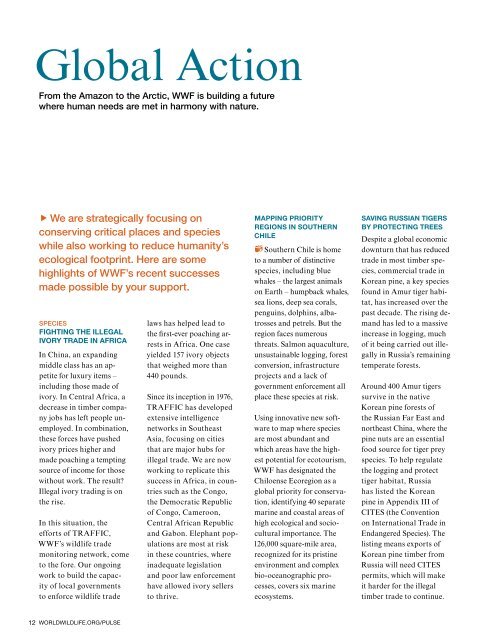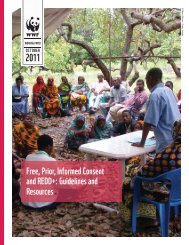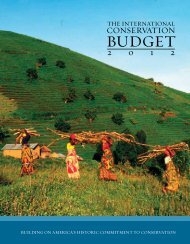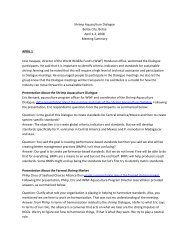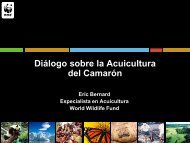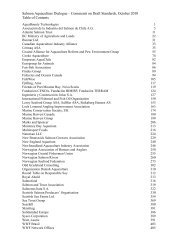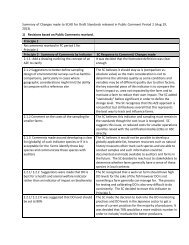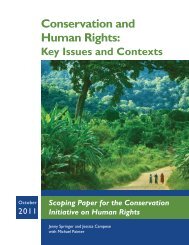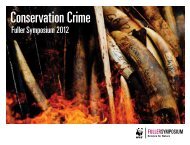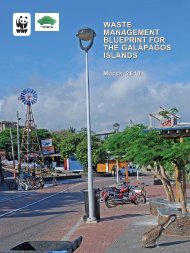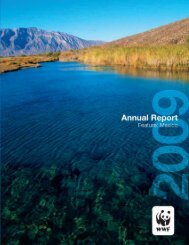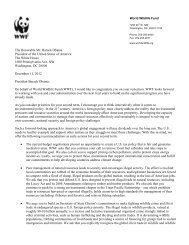Amazon - World Wildlife Fund
Amazon - World Wildlife Fund
Amazon - World Wildlife Fund
Create successful ePaper yourself
Turn your PDF publications into a flip-book with our unique Google optimized e-Paper software.
Global Action<br />
From the <strong>Amazon</strong> to the Arctic, WWF is building a future<br />
where human needs are met in harmony with nature.<br />
Blue whales are among the many<br />
species found along the coasts<br />
of Southern Chile, where WWF is<br />
helping to identify marine areas for<br />
future protection.<br />
We are strategically focusing on<br />
conserving critical places and species<br />
while also working to reduce humanity’s<br />
ecological footprint. Here are some<br />
highlights of WWF’s recent successes<br />
made possible by your support.<br />
SPECIES<br />
FIGHTING THE ILLEGAL<br />
ivory TRADE IN AFRICA<br />
In China, an expanding<br />
middle class has an appetite<br />
for luxury items –<br />
including those made of<br />
ivory. In Central Africa, a<br />
decrease in timber company<br />
jobs has left people unemployed.<br />
In combination,<br />
these forces have pushed<br />
ivory prices higher and<br />
made poaching a tempting<br />
source of income for those<br />
without work. The result?<br />
Illegal ivory trading is on<br />
the rise.<br />
In this situation, the<br />
efforts of trAFFIC,<br />
WWF’s wildlife trade<br />
monitoring network, come<br />
to the fore. Our ongoing<br />
work to build the capacity<br />
of local governments<br />
to enforce wildlife trade<br />
laws has helped lead to<br />
the first-ever poaching arrests<br />
in Africa. One case<br />
yielded 157 ivory objects<br />
that weighed more than<br />
440 pounds.<br />
Since its inception in 1976,<br />
trAFFIC has developed<br />
extensive intelligence<br />
networks in Southeast<br />
Asia, focusing on cities<br />
that are major hubs for<br />
illegal trade. We are now<br />
working to replicate this<br />
success in Africa, in countries<br />
such as the Congo,<br />
the Democratic Republic<br />
of Congo, Cameroon,<br />
Central African Republic<br />
and Gabon. Elephant populations<br />
are most at risk<br />
in these countries, where<br />
inadequate legislation<br />
and poor law enforcement<br />
have allowed ivory sellers<br />
to thrive.<br />
MAPPing Priority<br />
regions IN SOUTHERN<br />
Chile<br />
Southern Chile is home<br />
to a number of distinctive<br />
species, including blue<br />
whales – the largest animals<br />
on Earth – humpback whales,<br />
sea lions, deep sea corals,<br />
penguins, dolphins, albatrosses<br />
and petrels. But the<br />
region faces numerous<br />
threats. Salmon aquaculture,<br />
unsustainable logging, forest<br />
conversion, infrastructure<br />
projects and a lack of<br />
government enforcement all<br />
place these species at risk.<br />
Using innovative new software<br />
to map where species<br />
are most abundant and<br />
which areas have the highest<br />
potential for ecotourism,<br />
WWF has designated the<br />
Chiloense Ecoregion as a<br />
global priority for conservation,<br />
identifying 40 separate<br />
marine and coastal areas of<br />
high ecological and sociocultural<br />
importance. The<br />
126,000 square-mile area,<br />
recognized for its pristine<br />
environment and complex<br />
bio-oceanographic processes,<br />
covers six marine<br />
ecosystems.<br />
SAVING RUSSIAN TIGERS<br />
BY PROTECTING TREES<br />
Despite a global economic<br />
downturn that has reduced<br />
trade in most timber species,<br />
commercial trade in<br />
Korean pine, a key species<br />
found in Amur tiger habitat,<br />
has increased over the<br />
past decade. The rising demand<br />
has led to a massive<br />
increase in logging, much<br />
of it being carried out illegally<br />
in Russia’s remaining<br />
temperate forests.<br />
Around 400 Amur tigers<br />
survive in the native<br />
Korean pine forests of<br />
the Russian Far East and<br />
northeast China, where the<br />
pine nuts are an essential<br />
food source for tiger prey<br />
species. To help regulate<br />
the logging and protect<br />
tiger habitat, Russia<br />
has listed the Korean<br />
pine in Appendix III of<br />
Cites (the Convention<br />
on International Trade in<br />
Endangered Species). The<br />
listing means exports of<br />
Korean pine timber from<br />
Russia will need Cites<br />
permits, which will make<br />
it harder for the illegal<br />
timber trade to continue.<br />
© WWF Chile / ThOMAs CROWLEY<br />
12 worlDWildliFE.ORG/pulse Pulse: The hEART of consERvATion 13


